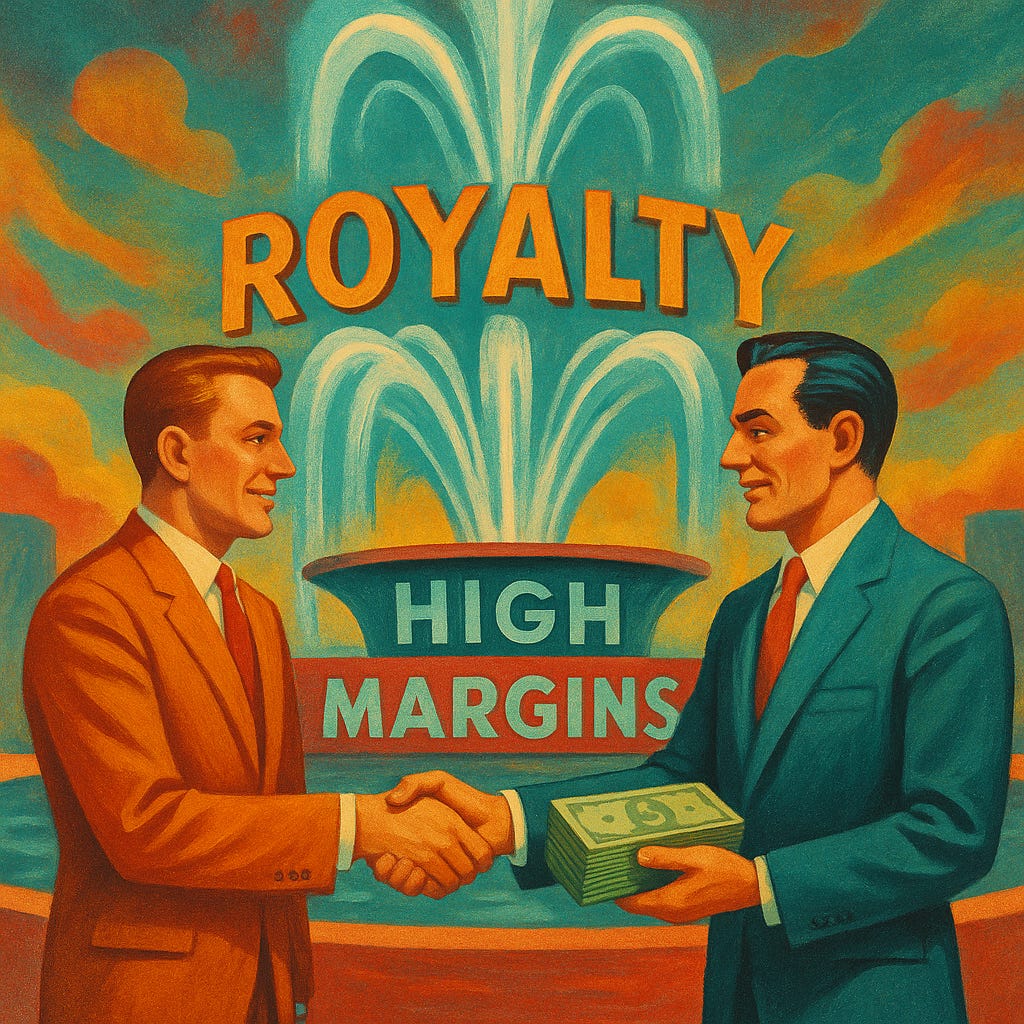Nathan's Famous: A Royalty Machine at 12x EBIT Masquerading as a Commodity Business
When Predictable Cash Flows + a Potential Sale Creates Lots of Upside (with Limited Downside)
Every investor eventually learns that the best opportunities don’t always come dressed up in growth stories. Sometimes they hide in plain sight – slow-moving, under-followed, even dismissed as “boring.”
Those are sometimes the most interesting opportunities.
This particular stock trades at 12x EBIT. On a screen, it looks like just another consumer staple stuck in neutral. But when you actually model it out, the math tells a different story.
Even with little revenue growth, you can pencil in decent IRRs just from high-margin (almost 100%) steady royalties – which are contractually guaranteed to increase by 3% YoY –, modest buybacks, and continued discipline in capital allocation (the company paid a special dividend twice!).
If you add in a mild multiple re-rating or a strategic catalyst (such as a potential sale of the business), the return profile could shift from “fine” to “very compelling” while the downside seems limited at the current valuation.
So why hasn’t the market noticed? Part of the answer is perception. On the surface, this looks like a commodity business in a tired category – the kind of thing investors assume is vulnerable to private label and changing consumer tastes. Another reason is scale. With a market cap of only about $400 million and a tightly held float due to almost 40% insider ownership, it simply isn’t big enough or liquid enough to attract big institutional money. The result is a stock that gets mostly ignored, even though its underlying economics look nothing like what the market assumes – in fact, they resemble the royalty-heavy models of companies like Domino’s, Dunkin’, Hershey’s, or even Playboy, where the brand does the heavy lifting and others handle the capital intensity.
And then there’s the aluded to optionality of being acquired. The Financial Times reported about it earlier this year. An acquisition could provide the kind of upside that doesn’t show up in a screener, but if it materializes sooner than later, could really boost the returns of current investors in a single announcement. It isn’t the base case, but it’s out there – and for anyone paying attention, it changes the skew of the investment dramatically.
That’s what makes this worth a closer look right now. You have a business with real staying power, cash flows that keep compounding in the background, a management team that has already proven willing to hand cash back to shareholders, and a valuation that bakes in next to nothing beyond survival. It’s rare to find setups where the downside seems anchored by visible cash flow while the upside could come from multiple different levers. This one fits that mold. The trick is separating the genuine durability from the real risks – and that’s the balance I’ll try to unpack in the rest of this post.
What will be covered:
A high-level pitch framed the way Bill Miller and Bill Ackman would think about it – five “bams” and the stone-tablet checklist.
The surprising evolution of this business, from humble beginnings to an asset-light model that looks nothing like what most investors assume.
How the company actually makes money on a per-unit basis, and why the economics are more interesting than the category suggests.
A management story that’s unusual for a small-cap: decades of continuity, real skin in the game, and a distinctive capital return strategy.
A moat analysis that asks the uncomfortable questions
The three KPIs that truly move the needle for long-term value creation here.
A valuation chapter that contrasts what’s priced in today with what would need to go right for upside + current multiples, FCF yield, future growth drivers, and peer comps
A discussion of a potential sale (rumors started surfacing earlier this year).
The risks that can’t be ignored – concentration, category headwinds, and governance dynamics.
A bottom line that ties the thesis together and leaves you with the core takeaway.
The 90-Second Pitch
Every investor I respect seems to have their own shorthand for what makes a stock compelling. Bill Miller swears by the 90-second pitch – the five “bams” that force you to boil a thesis down to its essence.
This is where it gets interesting.
Become a paying subscriber to read the rest of this post and get access to all of my other research, including valuation spreadsheets, deep dives (e.g. LVMH, Edenred, Digital Ocean, or Ashtead Technologies), and powerful investing frameworks.
Annual members also get access to my private WhatsApp groups – daily discussions with like-minded investors, analysis feedback, and direct access to me.
PS: Using the app on iOS? Apple doesn’t allow in-app subscriptions without a big fee. To keep things fair and pay a lower subscription price, I recommend just heading to the site in your browser (desktop or mobile) to subscribe.


